CRITICAL INTRODUCTION
TO VOLUME 4 OF THE DIAL (1896)
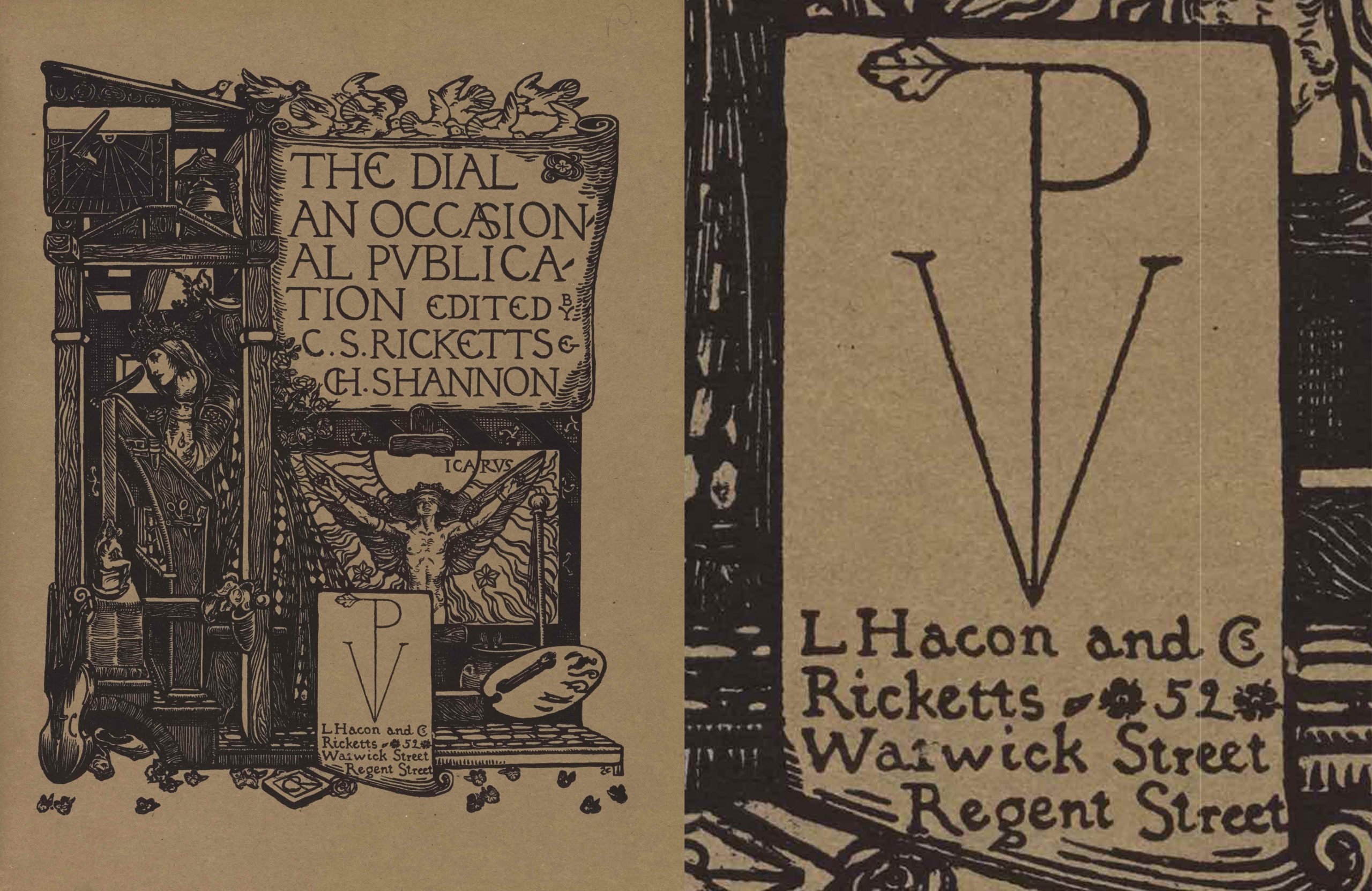
In March 1896 Charles Ricketts and Charles Shannon issued 270 copies of the fourth number of The Dial, priced at 12 shillings 6 pence. It had been two-and-a-half years since they had last published their little magazine, a fact not missed by the press. “The Dial’s’ visits are like the angels,” observed the Saturday Review critic, “and therefore the more welcome”: despite being few and far between, they were always dazzling when they arrived (“The Dial,” Saturday).
Since publishing the Dial’s third number, Ricketts had been occupied with establishing the Vale Press with his new business partner, barrister Llewellyn Hacon (1860-1910). Ricketts designed both types and ornaments for his new venture in treating books as total works of art. The engraving of the fonts alone took him a year, while a single decorative border could take as much as a month (Delaney 95-6). The shopfront, “At The Sign of the Dial,” was at 52 Warwick Street. Here patrons could purchase copies of the Dial, original prints and drawings by contributors, and, of course, Vale Press books when they came out.
Just as the Vale Press signage signalled its link to the Dial, so too the magazine’s fourth issue pointed to the launch of the Press. Proud to bring out the Vale Press’s first major publication, Ricketts engraved the elegant logo—initials with a fleuron—on the front cover (fig. 1) and inserted a four-page booklet of specimen type and ornament as part of the issue’s art contents. The paratext surpassed the host text. Declaring the insert to be “more important even than the fourth appearance of a ‘Dial,’” the Saturday Review celebrated “the designing and casting of such a type [as] an event, and one which will surely influence the condition of printing in our day” (ibid.). Although not all contemporary critics praised the new type, this reviewer was prescient. The Vale Press (1896-1904) went on to have significant impact on the small press movement at the turn of the century and beyond. In 1930 A. J. A. Symons averred that the modern typographer and designer originated with Ricketts, a claim that continues to be made today.
Between the Dial’s third number in 1893 and its fourth in 1896, much had happened in the world of avant-garde print culture. The most famous little magazine of the period, The Yellow Book, launched in April 1894 and ran until April 1897; its controversial contents and associations coloured the decade, which became known as “the yellow nineties.” Other little magazines quickly followed, including the Scottish Evergreen: A Northern Seasonal (1895-1896/7), The Savoy (1896), and The Pageant (1896-97). Shannon and Gleeson White brought out the latter as a Christmas annual, aiming for commercial success in a market of buyers interested in art and literature in a Pre-Raphaelite vein. Noting that “Art quarterlies, sprung into vogue through the ‘Yellow Book,’…have come to flourish among us since the ‘Dial’ began its highly occasional career,” the Saturday Review critic went on to say that the magazine launched in 1889 “remains the same, uninfluenced by passing fashions” (“The Dial,” Saturday). As recognized leaders in the decade’s new art, Ricketts and Shannon had, of course, been invited to contribute to the Yellow Book. However, the artists excused themselves, fearing this “might lead to complications over the fourth Dial” (qtd in Delaney 85). Nevertheless, they were on friendly terms with a number of Yellow Book contributors (though never with Aubrey Beardsley), including Charles Conder, Laurence Housman, and William Rothenstein. It was Rothenstein who introduced Ricketts and Shannon to Llewellyn Hacon, who became partner in the Vale Press (Delaney 92). When Ricketts and Shannon moved to Beaufort Street, Hacon and his new bride Edith Broadbent (1874?-1953), also known as Amaryllis or “Ryllis,” moved into the Vale, Chelsea. Here they continued the former tenants’ hospitable practice of hosting literary and artistic friends (Delaney 95).
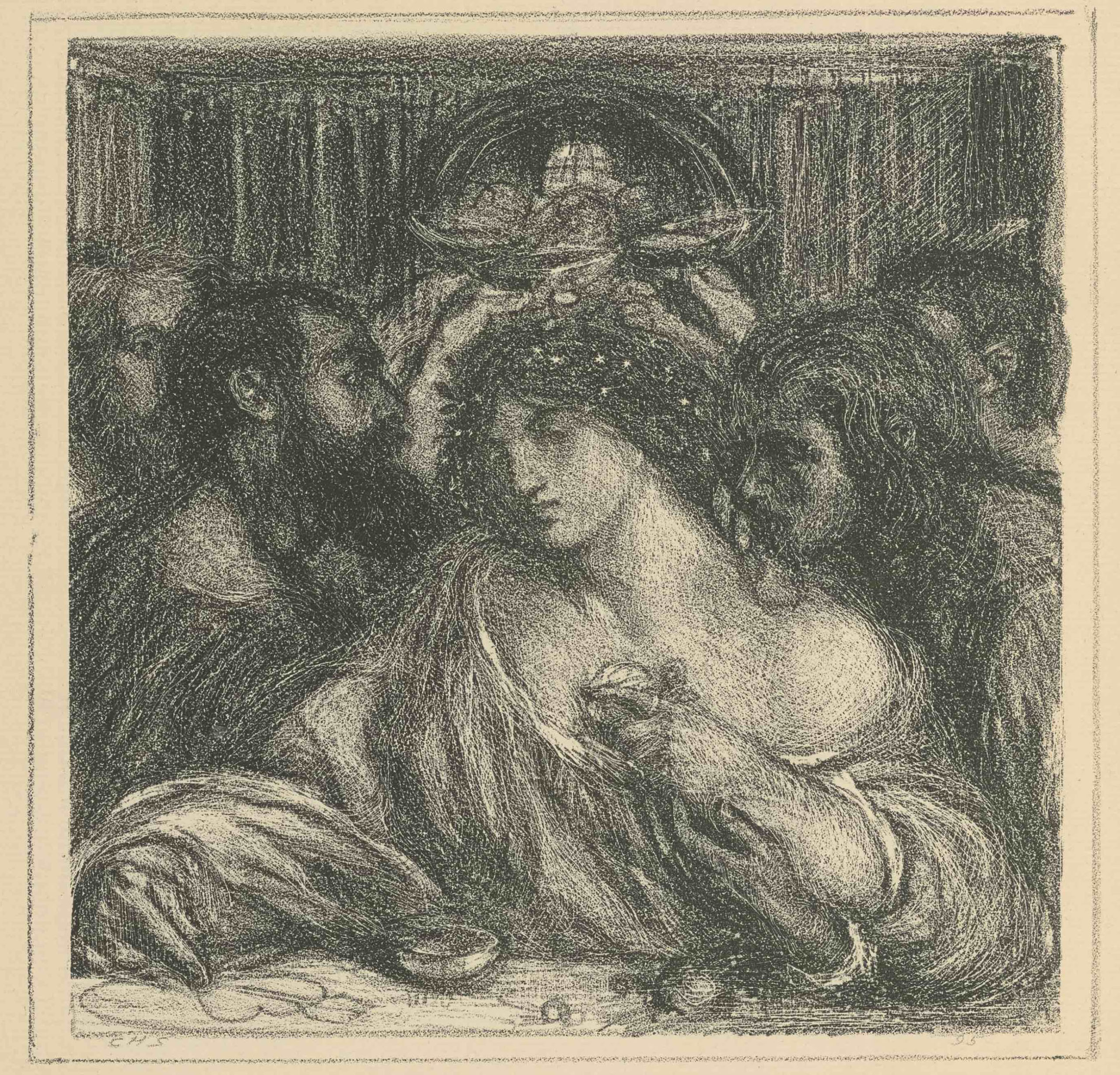
The frontispiece for Dial No. 4, “Delia,” is an original lithograph drawn on the stone by Charles Shannon, but not, as in previous practice, printed by the artist himself; this work was given to the professional lithographer Thomas Way. The subject of the artwork—sometimes also titled “In the House of Delia”— is based on a classical Latin poet, Albius Tibullus, whose first book of poems celebrated his love of a woman named Delia, whom he finds is receiving other lovers as well as himself. The classical reference had present-day associations, which the composition highlights in its figures. Shannon’s model for Delia was Edith, the beautiful wife of Ricketts’s business partner, known as Amaryllis or Ryllis to her friends. Ryllis was a popular artist’s model: Rothenstein’s “Portrait of a Lady” in the first Yellow Book features her, and Conder drew her and Hacon naked on the beach near their Scottish property in Dornach in 1895. Before her marriage, Ryllis had been a mistress of Herbert Horne and Arthur Symons. The latter used her life story as the basis for the two- part serial, “Lucy Newcombe,” published in The Savoy, volumes 2 and 8. In Shannon’s lithograph, the contemporary scene overlays classical allusion. Ryllis/Delia sits behind a table, tracing a heart on its surface and holding a rose; she is flanked on the left by Shannon and the right by Ricketts. Behind, a group of men raise their glasses in a toast. Perhaps the image celebrates the ongoing appreciation of beauty and art at the Vale, Chelsea, and the Vale Press, Warwick St.
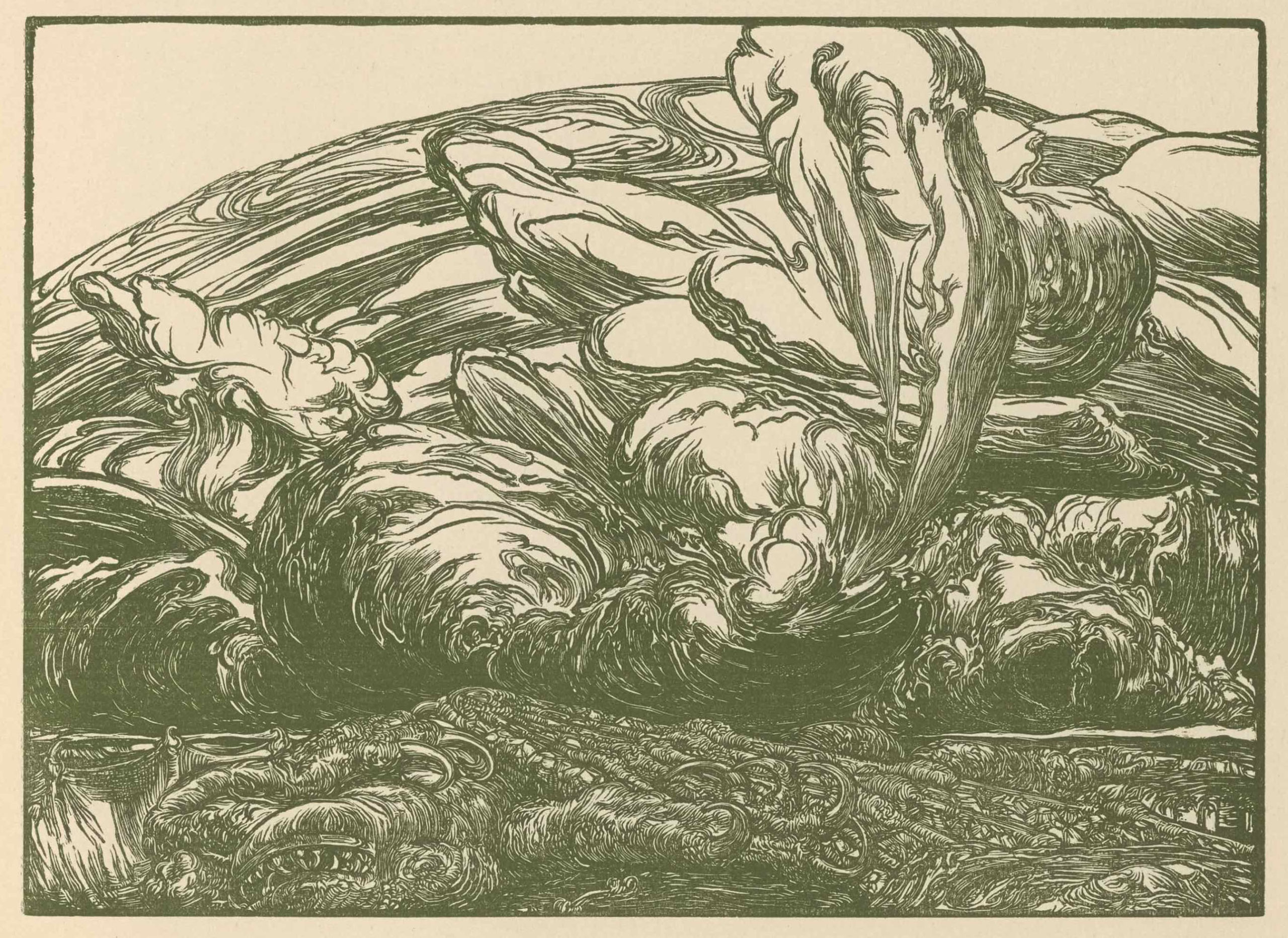
The editorial arrangement of the art pieces in this issue groups works by medium and/or artist. The first three artworks, praised as “exquisite” by the Saturday Review (“The Dial”), are by Shannon. “Delia” is followed by a silverpoint drawing, “A Study of Mice,” reproduced by the Swan Electric Company. This trio of works is completed by “Atalanta,” another original lithograph printed by Way. Next come three original woodcuts. The first, by Lucien Pissarro, is an enchanting depiction of Little Red Riding Hood meeting the wolf in the woods. “Le Petit Chaperon Rouge,” the Saturday Review applauded, “is as full of charm as it is admirable in workmanship” (“The Dial”). The other two woodcuts, both by Thomas Sturge Moore, also take their subjects from fairy tales. “The Death of the Dragon” depicts an apocalyptic scene of smoke, fire, and clouds shaped in a confusion of masses and funnels; below, grotesque with extreme foreshortening, the dragon lies on its back with glazed eyes and bared teeth, a furled wing draped over its scaled body (fig. 3). When exhibited later at the Dutch Gallery, the reviewer was awed by the woodcut’s depiction of “a portentous upboiling of the elements in the coils and explosions of vapour” (D.S.M.). In contrast, Moore’s “Baby Giants” places a pastoral and playful scene into a woodcut so small it could easily be used as a textual ornament or headpiece. Compressed into a tiny space of about 2” x 1,” two naked young giants wrestle while a third, possibly a female, reclines on the ground holding a blossoming branch.
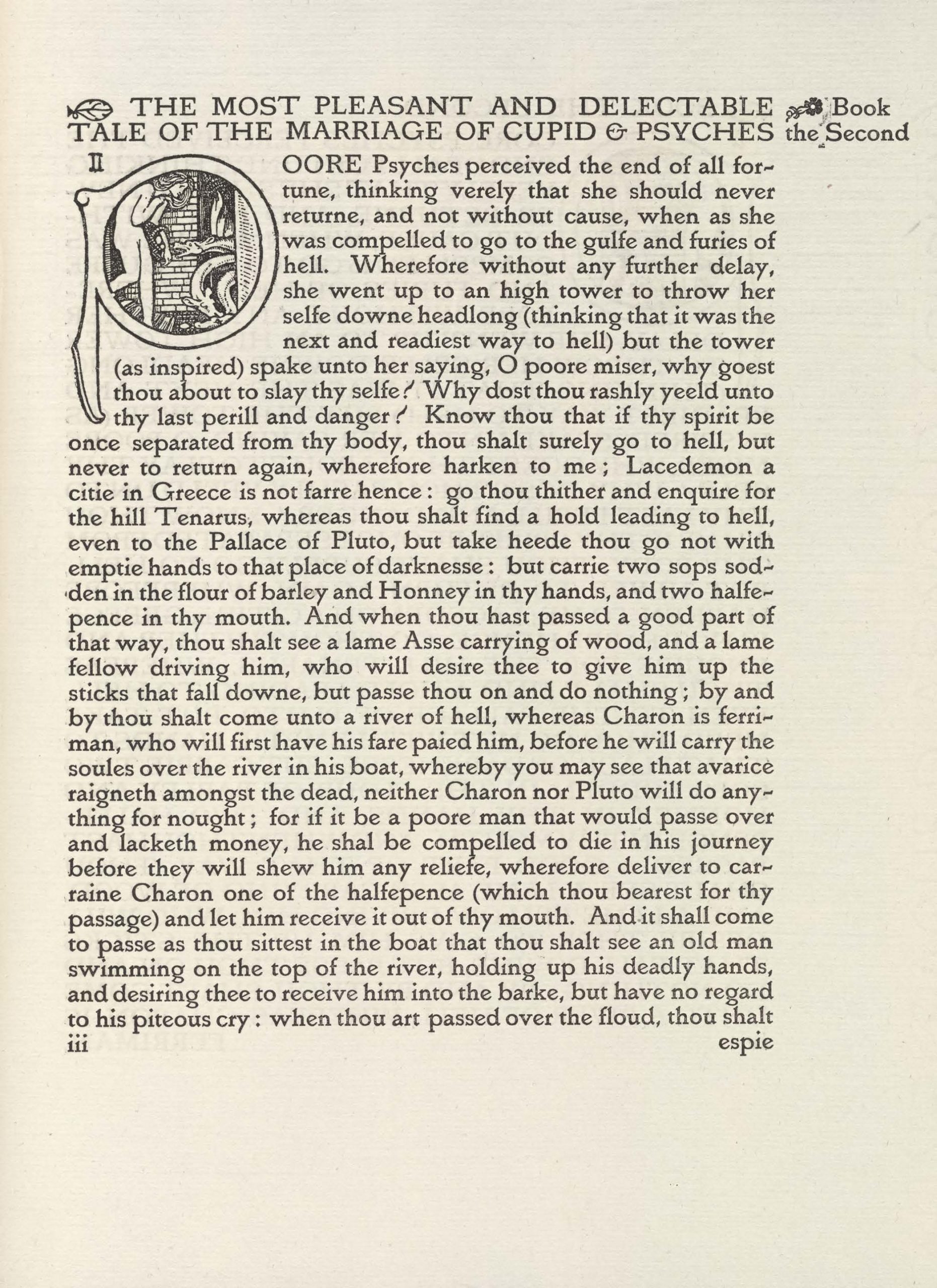
Of the last three artworks, two are by Charles Ricketts, and one by Reginald Savage. It is worth noting that the editors list Ricketts’s “Two Pages of the Vale Type (with initial)” in the art contents, thus making their point that typography and wood-engraved ornament are as worthy of study for their beauty as other art forms (fig. 4). Inserted within the Dial’s folio format, Ricketts’s Vale Press specimen booklet is distinctive, as it is folded to quarto size and printed on a thicker paper, watermarked “Unbleached Arnold (Ruskin)” (Watry 40). Paradoxically, the Vale Press insert in the Dial is both commercial advertisement and visual art. The specimen pages of Vale type, like the Dial itself, attest to Ricketts’s belief that “a work of art is a whole in which each portion is exquisite in itself yet co-ordinate” (Ricketts, Introduction, 120).
Two extremely fine pen-and-ink-drawings, both reproduced photomechanically by the Swan Electric Engraving Company, complete the art contents of volume 4. Ricketts’s diptych design for “The King’s Quair” was made for a projected Vale Press edition that was later determined to be too ambitious. A simpler version, without ornament or illustration, was published in 1903 (Ricketts, Defense 106). Reginald Savage’s incredibly compressed and claustrophobic “Wotan and Logi Depart in Search of the Reingold” takes its subject from Wagner’s then-popular Ring cycle and its style from the Pre-Raphaelite illustrations of the 1860s. Savage’s pen-and-ink design in the previous Dial, “The Lotos-Eaters,” had been favourably compared to the admired Pre-Raphaelite illustrations in the Moxon Tennyson (1857), but despite similarities in detail, conception, and style, “Wotan and Logi” was not called out for special praise in the reviews (Theocritus, IV–Reginald Savage).
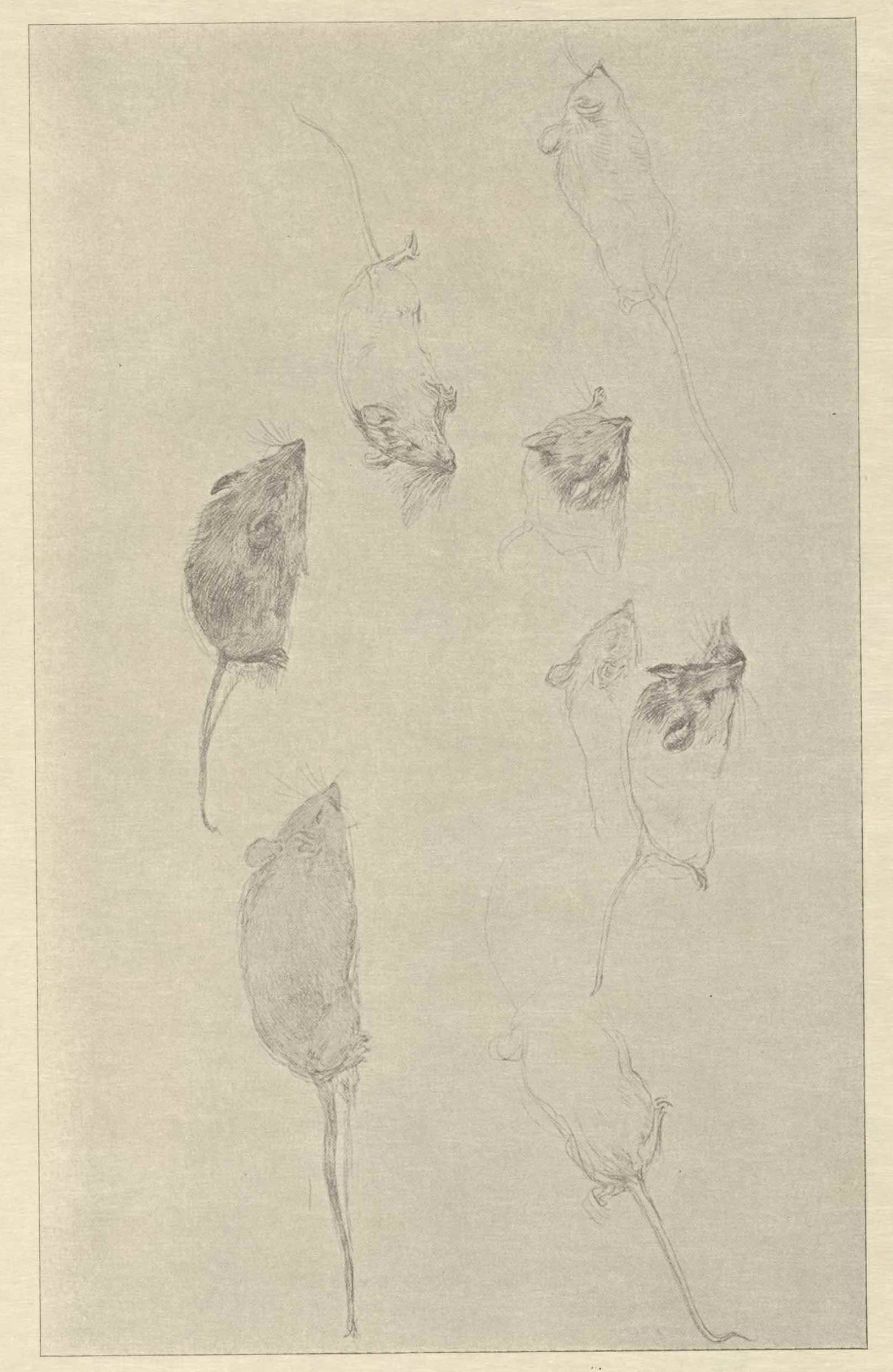
While the artwork of the fourth Dial was well received, the Spectator critic seemed to voice the general view that “the literary part is not equal to these illustrations” (“The Dial,” Spectator). Moreover, as the Saturday Review noted, “Mr. John Gray pervades the letterpress, both in prose and verse” (“The Dial”): in fact, he contributed five of the eight literary pieces in the volume. Part of the coterie of Dial contributors from the start, Gray’s collaboration with Ricketts reached a peak in 1893, with the publication of his first collection of poetry, Silverpoints, designed in a unique long, narrow format by Ricketts and brought out by John Lane and Elkin Mathews at The Bodley Head. Gray’s title refers to the artistic method Shannon used in his “Study of Mice” (fig. 5). Gray’s title, James Nelson suggests, deliberately emphasized the “close relationship in his mind between his poems and this particularly subtle and shadowy form of art” (200). The editorial choice to include Shannon’s only silverpoint in the fourth Dial also suggests that the editors wished to draw attention to the close relationship between art and literature in their magazine by alluding to Gray’s book in this subtle way. Shannon’s ghostly mice, like Gray’s “Flying Fish” in the long narrative poem that initiates the letterpress, and his lamb in the prose fable “The Beauties of Nature,” also query the relations between art and nature. These themes, as Linda Dowling observes, are dominant throughout Gray’s work (169); they are also pervasive throughout the Dial. Stylistically, “The Flying Fish” is, according to Geoffrey Grigson, Gray’s “difficult single masterpiece” and “one of the fine ‘modern’ poems” often overlooked by twentieth-century critics (644).
Gray contributed another narrative poem, “Battledore,” and the only essay in the volume, a review of J.K. Huysman’s En-Route (1895). Thomas Sturge Moore offered the symbolic poem “Prayer to Venus.” Following past practice, only the prose pieces in the Dial were ornamented with decorative initial letters. In the fourth volume, there were only a total of three initials (not counting the initial included with the Vale Press specimen), all designed and engraved by Ricketts. He was clearly experimenting with these decorative devices. Although two of the three initials featured a capital “I,” the interlacing was unique for each, and also distinct from the decorative initial “I” used in the previous volume (see Database of Ornament).
For the first time in its existence, The Dial published two authors outside the original coterie, including two women, Katharine Bradley and Edith Cooper, who published under the joint name Michael Field. After admiring their Tragic Mary, with a cover designed by Selwyn Image, at the Arts and Crafts Exhibition in 1890, Ricketts and Shannon sent the two poets a copy of the Dial. Rothenstein later brought the Fields to meet them at the Vale, and the two couples remained friends for over two decades (Delaney 87). Michael Field contributed an ekphrastic sonnet, “On a Portrait by Tintoret in the Colonna Gallery” to the fourth volume. The other newcomer to the Dial was Delaplaine Scull, a relatively little-known painter and writer from Somerset who occasionally contributed to little magazines. Set in medieval Italy, his “The Writing on the Wall” is a triangular tale featuring a painter, a model, and an envious husband engaged in art, intrigue, betrayal, love, and death. With its themes of art, life, and beauty, the story signals its Pre-Raphaelite lineage.
The fourth and penultimate issue of the Dial introduced the arts of typography and silverpoint as well as a few new writers, while maintaining a Pre-Raphaelite interest in the relationships of art, literature, and nature, and a commitment to design and the magazine as a total work of art.
©2020 Lorraine Janzen Kooistra, FRSC, Professor of English, Ryerson University
Works Cited
- Grigson, Geoffrey. “Dorian Gray: John Gray.” The New Statesman, 26 April 1963, p. 644. Periodicals Archive Online, ProQuest. Delaney, J.G.P. Charles Ricketts: A Biography. Clarendon Press, 1990.
- “The ‘Dial’: An Occasional Publication.” Rev. of The Dial, vols. 1-4, 1889-1896, The Saturday Review, vol. 81, no. 2113, 25 April 1896, p. 439. Yellow Nineties 2.0, edited by Lorraine Janzen Kooistra, Ryerson University Centre for Digital Humanities, 2020. https://www.1890s.ca/dial1-4-review-the-saturday-review-april-1896/
- “The ‘Dial’: An Occasional Publication.” Rev. of The Dial, The Spectator, vol. 76, no. 3545, 6 June 1896, p. 4814. Yellow Nineties 2.0, edited by Lorraine Janzen Kooistra, Ryerson University Centre for Digital Humanities, 2020. https://beta.1890s.ca/dial4-review-the-spectator-jun-1896/
- D.S.M. “An Exhibition of Original Wood Engravings.” The Saturday Review, vol. 86, no. 2250, 10 December, 1898, pp. 778-779. Yellow Nineties 2.0, edited by Lorraine Janzen Kooistra, Ryerson University Centre for Digital Humanities, 2020. https://www.1890s.ca/dial-review-the-saturday-review-dec-1898/
- Dowling, Linda. “John Gray’s Silverpoints.” Victorian Poetry, vol. 15, no. 2, 1977, pp. 159-169.
- Field, Michael. “On a Portrait by Tintoret in the Colonna Gallery.” The Dial, vol. 4, 1896, p. 18. The Dial Digital Edition, edited by Lorraine Janzen Kooistra, Yellow Nineties 2.0, Ryerson University Centre for Digital Humanities, 2020. https://beta.1890s.ca/dialv4-field-portrait/
- Gray, John. “Battledore.” The Dial, vol. 4, 1896, pp. 34-36. The Dial Digital Edition, edited by Lorraine Janzen Kooistra, Yellow Nineties 2.0, Ryerson University Centre for Digital Humanities, 2020. https://beta.1890s.ca/dialv4-gray-battledore/
- —. “The Beauties of Nature.” The Dial, vol. 4, 1896, pp. 15-17. The Dial Digital Edition, edited by Lorraine Janzen Kooistra, Yellow Nineties 2.0, Ryerson University Centre for Digital Humanities, 2020. https://beta.1890s.ca/dialv4-gray-beauties/
- —. “En Route” [The Redemption of Durtal].” The Dial, vol. 4, 1896, pp. 7-11 . The Dial Digital Edition, edited by Lorraine Janzen Kooistra, Yellow Nineties 2.0, Ryerson University Centre for Digital Humanities, 2020. https://beta.1890s.ca/dialv4-gray-redemption/
- —. “The Flying Fish.” The Dial, vol. 4, 1896, pp. 1-6. The Dial Digital Edition, edited by Lorraine Janzen Kooistra, Yellow Nineties 2.0, Ryerson University Centre for Digital Humanities, 2020. https://beta.1890s.ca/dialv4-gray-flying/
- Haldane, David. “Thomas Way.” Dictionary of Nineteenth-Century Journalism, edited by Laurel Brake and Marysa Demoors, C19 Index, ProQuest, http://gateway.proquest.com/openurl?url_ver=Z39.88-2004—res_dat=xri:c19
- Moore, T. Sturge. “Baby Giants.” The Dial, vol. 4, 1896, np. The Dial Digital Edition, edited by Lorraine Janzen Kooistra, Yellow Nineties 2.0, Ryerson University Centre for Digital Humanities, 2020. https://beta.1890s.ca/dialv4-moore-giants-AE/
- —. “The Death of the Dragon.” The Dial, vol. 4, 1896, np. The Dial Digital Edition, edited by Lorraine Janzen Kooistra, Yellow Nineties 2.0, Ryerson University Centre for Digital Humanities, 2020. https://beta.1890s.ca/dialv4-moore-dragon-AD/
- —. “A Prayer to Venus.” The Dial, vol. 4, 1896, pp. 12-14. The Dial Digital Edition, edited by Lorraine Janzen Kooistra, Yellow Nineties 2.0, Ryerson University Centre for Digital Humanities, 2020. https://beta.1890s.ca/dialv4-moore-prayer/
- Nelson, James G. The Early Nineties: A View from The Bodley Head, Harvard University Press, 1971.
- Pissarro, Lucien. “Le Petit Chaperon Rouge.” The Dial, vol. 4, 1896, np. The Dial Digital Edition, edited by Lorraine Janzen Kooistra, Yellow Nineties 2.0, Ryerson University Centre for Digital Humanities, 2020. https://beta.1890s.ca/dialv4-pissarro-chaperon-AC/
- Ricketts, Charles. A Defense of the Revival of Printing (1899). Charles Ricketts, Everything for Art: Selected Writings, edited with an introduction by Nicholas Frankel, The Rivendale Press, 2014, 95-112.
- —. “An Illustration to the King’s Quair.” The Dial, vol. 4, 1896, np. The Dial Digital Edition, edited by Lorraine Janzen Kooistra, Yellow Nineties 2.0, Ryerson University Centre for Digital Humanities, 2020. https://beta.1890s.ca/dialv4-ricketts-quair-AF/
- —. Introduction. A Bibliography of Books Issued by Hacon and Ricketts (1904). Charles Ricketts, Everything for Art: Selected Writings, edited with an introduction by Nicholas Frankel, The Rivendale Press, 2014, 118-126.
- —. “Two Pages of the Vale Type (with initials).” The Dial, vol. 4, 1896, np. The Dial Digital Edition, edited by Lorraine Janzen Kooistra, Yellow Nineties 2.0, Ryerson University Centre for Digital Humanities, 2020. https://beta.1890s.ca/dialv4-ricketts-vale-type-ag/
- Rothenstein, William. “Portrait of a Lady.” The Yellow Book, vol. 1, Apr. 1894, pp. 151. The Yellow Book Digital Edition, edited by Dennis Denisoff and Lorraine Janzen Kooistra, 2010-2015. Yellow Nineties 2.0, Ryerson University, 2020. https://beta.1890s.ca/yb1-rothenstein-lady/
- Savage, Reginald. “Wotan and Logi Depart in Search of the Reingold.” The Dial, vol. 4, 1896, np. The Dial Digital Edition, edited by Lorraine Janzen Kooistra, Yellow Nineties 2.0, Ryerson University Centre for Digital Humanities, 2020. https://beta.1890s.ca/dialv4-savage-wotan-AH/
- Scull, W. Delaplaine. “The Writing on the Wall.” The Dial, vol. 4, 1896, pp. 19-33. The Dial Digital Edition, edited by Lorraine Janzen Kooistra, Yellow Nineties 2.0, Ryerson University Centre for Digital Humanities, 2020. https://beta.1890s.ca/dialv4-scull-writing/
- Shannon, Charles. “Atalanta.” The Dial, vol. 4, 1896, np. The Dial Digital Edition, edited by Lorraine Janzen Kooistra, Yellow Nineties 2.0, Ryerson University Centre for Digital Humanities, 2020. https://beta.1890s.ca/dialv4-shannon-atalanta-AB/
- —. “Delia.” The Dial, vol. 4, 1896, np. The Dial Digital Edition, edited by Lorraine Janzen Kooistra, Yellow Nineties 2.0, Ryerson University Centre for Digital Humanities, 2020. https://beta.1890s.ca/dialv4-shannon-frontispiece/
- —. “A Study of Mice.” The Dial, vol. 4, 1896, np. The Dial Digital Edition, edited by Lorraine Janzen Kooistra, Yellow Nineties 2.0, Ryerson University Centre for Digital Humanities, 2020. https://beta.1890s.ca/dialv4-shannon-mice-aa/
- —. “Symons, A.J.A. “An Unacknowledged Movement in Fine Printing: (1930), The Fleuron Anthology, edited by F. Meynell and H. Simon, David Godine 1979, pp. 300-325.
- Symons, Arthur. “Pages from the Life of Lucy Newcome.” The Savoy, vol. 2, April 1896, pp. 147-160. Savoy Digital Edition, edited by Christopher Keep and Lorraine Janzen Kooistra, 2018-2020. Yellow Nineties 2.0, Ryerson University Centre for Digital Humanities, 2019. https://1890s.ca/savoyv2-symons-lucy/
- Theocritus. “The Vale Artists, IV.—Reginald Savage.” The Sketch, vol. 9, April 21, 1895, p. 683. The Dial Digital Edition, edited by Lorraine Janzen Kooistra, Yellow Nineties 2.0, Ryerson University Centre for Digital Humanities, 2020. https://beta.1890s.ca/dial-review-the-sketch-apr-21-1895/
- Watry, Maureen. The Vale Press: Charles Ricketts, A Publisher in Earnest, foreword by Nicolas Barker. Oak Knoll Press/The British Library, 2004.
MLA citation:
Kooistra, Lorraine Janzen. “Critical Introduction to Volume 4 of The Dial (1896)” The Dial Digital Edition, Yellow Nineties 2.0, 2019-2020, edited by Lorraine Janzen Kooistra, Ryerson University Centre for Digital Humanities, 2020, https://1890s.ca/dialv4_critical_introduction/